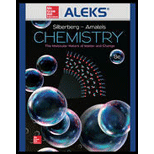
(a)
Interpretation:
The charge and full ground state electron configuration of the ion likely to be formed by
Concept introduction:
The electronic configuration of an atom describes how the electrons are ditributed in its atom among various shells and subshells. It is used to predict the chemical, physical, electrical and magnetic properties of the substance. The full electronic configuration of an atom tells about the distribution of electrons in the various atomic orbitals.
(b)
Interpretation:
The charge and full ground state electron configuration of the ion likely to be formed by
Concept introduction:
The electronic configuration of an atom describes how the electrons are ditributed in its atom among various shells and subshells. It is used to predict the chemical, physical, electrical and magnetic properties of the substance. The full electronic configuration of an atom tells about the distribution of electrons in the various atomic orbitals.
(c)
Interpretation:
The charge and full ground state electron configuration of the ion likely to be formed by
Concept introduction:
The electronic configuration of an atom describes how the electrons are ditributed in its atom among various shells and subshells. It is used to predict the chemical, physical, electrical and magnetic properties of the substance. The full electronic configuration of an atom tells about the distribution of electrons in the various atomic orbitals.
Want to see the full answer?
Check out a sample textbook solution
Chapter 8 Solutions
CHEMISTRY:MOLECULAR NATURE...-ALEKS 360
- Easily differentiate between electrochemical potential and Galvani potential.arrow_forwardConstruct a molecular orbital diagram for carbon monoxide. Identify the relevant point group,include all of the appropriate symmetry labels and pictures, and fill in the electrons. Make sure toaccount for the difference in electronegativity between C and O. Hint: CO is substantiallyisoelectronic to N2. (PLEASE DRAW THE ENTIRE MO DIAGRAM!!!)arrow_forwardplease help with hwarrow_forward
 ChemistryChemistryISBN:9781305957404Author:Steven S. Zumdahl, Susan A. Zumdahl, Donald J. DeCostePublisher:Cengage Learning
ChemistryChemistryISBN:9781305957404Author:Steven S. Zumdahl, Susan A. Zumdahl, Donald J. DeCostePublisher:Cengage Learning ChemistryChemistryISBN:9781259911156Author:Raymond Chang Dr., Jason Overby ProfessorPublisher:McGraw-Hill Education
ChemistryChemistryISBN:9781259911156Author:Raymond Chang Dr., Jason Overby ProfessorPublisher:McGraw-Hill Education Principles of Instrumental AnalysisChemistryISBN:9781305577213Author:Douglas A. Skoog, F. James Holler, Stanley R. CrouchPublisher:Cengage Learning
Principles of Instrumental AnalysisChemistryISBN:9781305577213Author:Douglas A. Skoog, F. James Holler, Stanley R. CrouchPublisher:Cengage Learning Organic ChemistryChemistryISBN:9780078021558Author:Janice Gorzynski Smith Dr.Publisher:McGraw-Hill Education
Organic ChemistryChemistryISBN:9780078021558Author:Janice Gorzynski Smith Dr.Publisher:McGraw-Hill Education Chemistry: Principles and ReactionsChemistryISBN:9781305079373Author:William L. Masterton, Cecile N. HurleyPublisher:Cengage Learning
Chemistry: Principles and ReactionsChemistryISBN:9781305079373Author:William L. Masterton, Cecile N. HurleyPublisher:Cengage Learning Elementary Principles of Chemical Processes, Bind...ChemistryISBN:9781118431221Author:Richard M. Felder, Ronald W. Rousseau, Lisa G. BullardPublisher:WILEY
Elementary Principles of Chemical Processes, Bind...ChemistryISBN:9781118431221Author:Richard M. Felder, Ronald W. Rousseau, Lisa G. BullardPublisher:WILEY





